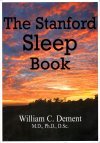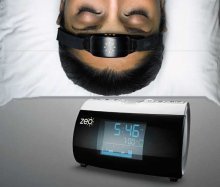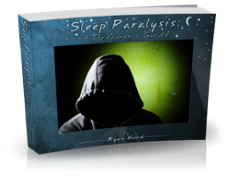
| Connect & Subscribe |
What You May Not Know About Insomnia
A Brochure
An Outreach Project by Peter Petrovics | Return To Outreach Projects 2010
The following is the text from a brochure created for Stanford Sleep and Dreams by a student in the class. Feel free to download this brochure for distributional or general information purposes. Please refer to our privacy policy for our relevant disclaimers.
What is insomnia and who discovered it?
Insomnia is difficulty falling asleep. It is an unfortunate sleep disorder, rather than a disease. Since the disorder has been experienced and observed frequently throughout human history, there is no individual who is responsible for having discovered it.
What types of insomnia are there?
Although there are many ways to classify insomnia, a popular classification is based on its persistence. If the symptoms of insomnia last less than one week, then these symptoms are called transient insomnia. Symptoms that last between one and three weeks can be referred to as short-term insomnia, and symptoms lasting longer than three weeks are called chronic insomnia. Another type of classification identifies differences in what causes insomnia. For example, primary insomnia is when the individual has sleep problems that are not directly related to health issues. Secondary insomnia is present when the individual's sleep problems are caused by something else, like a certain substance or health condition.
What percent of the population suffers from insomnia and who is most affected by it?
Approximately 30-50 % of individuals suffer from insomnia and 10 % suffer from chronic insomnia. It is a common symptom which affects people of all age groups. However, the incidence of insomnia tends to increase with age. Also, adult women tend to have insomnia more often than adult men. The sleep disorder is more common among individuals in lower socioeconomic backgrounds, mental health patients, and alcoholics. Travelers, seniors, shift workers, adolescent students, and pregnant women seem to be at higher risk for developing insomnia as well.
What causes insomnia?
Insomnia can be caused by situational, medical, or primary factors. Transient and short-term insomnia are caused by correctable stimuli such as uncomfortable temperatures, jet lag, noise disturbances, changes in shift work, stress (brought on by work, loss of loved ones, relationship problems, etc.), withdrawal from drugs, and the lack of sufficient oxygen at high altitudes. Chronic insomnia is caused by psychiatric or physiologic conditions.
Insomnia can be caused by situational, medical, or primary factors. Transient and short-term insomnia are caused by correctable stimuli such as uncomfortable temperatures, jet lag, noise disturbances, changes in shift work, stress (brought on by work, loss of loved ones, relationship problems, etc.), withdrawal from drugs, and the lack of sufficient oxygen at high altitudes. Chronic insomnia is caused by psychiatric or physiologic conditions. Psychological problems that cause insomnia include anxiety, schizophrenia, bipolar disorder and depression. There are also several physiological conditions which may cause insomnia. These include obstructive sleep apnea, nocturnal asthma, brain tumors, congestive heart failure, chest pain, chronic fatigue syndrome, and degenerative diseases such as Parkinson's disease. Certain medications, such as those prescribed for asthma and high blood pressure are also associated with insomnia.
What are the symptoms?
There are several important symptoms attributed to insomnia. They are all related to sleep deprivation and include memory difficulties, lack of concentration, impaired motor coordination, irritability, and strained social interactions. Sleepiness is a very serious symptom because it may easily lead to injury or death, as is often the case with automobile accidents. In general, the symptoms of insomnia are universally shared by other sleep disorders such as obstructive sleep apnea, narcolepsy, and REM behavior disorder. Symptoms of these disorders include the general symptoms associated with sleep deprivation (i.e. impaired motor coordination and difficulty focusing). However, each of these disorders has its own unique characteristics, such as snoring with sleep apnea and hypnagogic hallucinations with REM behavior disorder.
How can I treat insomnia?
When insomnia occurs often and affects the daytime functioning of an individual, he or she should seek some form of treatment. In general, there are two types of treatment: non-medical and medical. Non-medical treatment is referred to as cognitive behavioral therapy and includes therapies such as sleep hygiene and relaxation therapy. Treatment involving sleep hygiene is quite easy and very effective. For instance, the insomniac should exercise at least twenty minutes per day, preferably four to five hours before bedtime. Also, the insomniac should adhere to a rigid sleep and awakening schedule. It is also recommended that the individual not smoke, drink alcohol, or drink caffeinated beverages in the afternoon. The insomniac should avoid having an empty stomach and should try to resolve or put aside issues. Additionally, it is advisable to avoid watching TV or using a computer before bedtime. If possible, the insomniac should get rid of all sleep-disrupting stimuli such as light, noise, and uncomfortable temperature. Relaxation therapy is also effective and includes techniques such as playing relaxing music and meditating. Some experts believe that combining non-medical and medical treatments is most effective. Benzodiazepine sedatives and antihistamines are sedative drugs that have proven useful. However, antihistamines should not be used for chronic insomnia. Melatonin and Ramelteon have been effective in normalizing circadian rhythm disorders.
Who can I contact if I think I have insomnia?
American Academy of Family Physicians: http://familydoctor.org/online/famdocen/home/articles/110.html
National Center on Sleep Disorders Research Phone Number: (301) 435-0199
American Sleep Association: (Attend the Insomnia Awareness Week Event) http://www.sleepassociation.org/index.php?p=insomniaawarenessweek
National Sleep Foundation Phone Number: (202) 347-3471
About This Site
Welcome! This site is continuously being created by students of Dr. William C. Dement's Sleep And Dreams course at Stanford University.
We made this site as a call to action for people all over the world to live healthier, happier, safer, and more productive lives by learning about their own sleep. We have faith that reading the information provided on this site will motivate you to be smart about your sleep deprivation and strategic about your alertness in order to live life to your fullest, most energetic potential.
In fact, we challenge you to do so! What do you say, are you up for the challenge?
Interviews With Sleep Specialists: Insights Into the Worlds of Sleep Medicine & Sleep Business
America's Most Dangerous Disorder: What Is Sleep Apnea Doing To Your Sleep?
Sleep Debt: How Much More Will You Achieve When You Reduce Yours?
The Stages Of Sleep: The Journey Through The Night
Delayed Sleep Phase: You Want To Sleep But You're Not Tired Yet
Paralyzed at Night: Is Sleep Paralysis Normal?
Sleep In Words: Smart, Strange, and Funny Quotes About Sleep
Sleep Disorders In Children: What's Keeping Your Child From A Full Night's Rest?
Attacks of Pavor Nocturnus (a.k.a. Sleep Terrors, Night Terrors, or Incubus Attacks)
The Stanford Sleep Book
Dr. Dement's pioneering textbook has been the core text for Sleep and Dreams since 1980, but it has just recently been made available to the wider public for the first time.
In it you'll find a more detailed account of the most important things you need to know about sleep, alertness, dreams, and sleep disorders. Studies, statistics, plus plenty of Dr. Dement's classic anecdotes painting the history of sleep medicine.
Preface | Intro | Contents | Get A Copy
More Sleep Resources
The Zeo
A revolution in personal sleep tracking, the Zeo is a wireless headband that transmits your brainwaves in realtime to a dock (pictured here) or your smartphone. The result? You can wake up and see exactly what stages of sleep you were in during the night! Unprecedented personalized sleep knowledge.
Sleep Paralysis: A Dreamer's Guide
Ever woken up paralyzed? A surprising number of us have, believe it or not. But few know the actual causes of this phenomenon, and fewer still how to exert control over it. Dream researcher and sleep paralysis expert Ryan Hurd shares breakthrough insights into how to do just that.
Important Disclaimer
Please Note:
The information found on this page and throughout this site is intended for general information purposes only. While it may prove useful and empowering, it is NOT intended as a substitute for the expertise and judgments of healthcare practitioners.
For more info, see our
Terms of Use.









